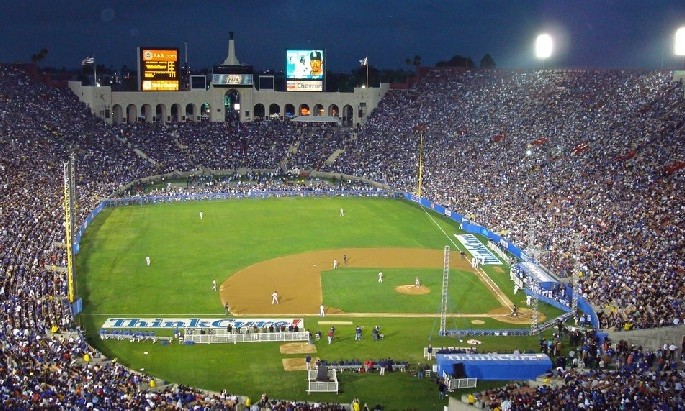Our last featured park was Exhibition Stadium in Toronto, a football stadium that somehow shoehorned the Blue Jays in. For the next stadium, we have a bit of a similar situation.
The Los Angeles Memorial Coliseum originally opened in 1923, and at the time, baseball wasn’t even a thought for the stadium. The USC football team has resided at the Coliseum since it opened, and the stadium has also hosted several NFL franchises, the Olympics, and the UCLA football team, among others. But, for four years, the Coliseum was also home of the Los Angeles Dodgers.
Baseball Goes West
The Dodgers, as many are aware, were originally from Brooklyn. In the 1950s, the team attempted to negotiate a new stadium from the borough, but the talks stalled. New owner Walter O’Malley, not to be deterred, began to talk with officials from Los Angeles.
L.A. officials told O’Malley that the Dodgers would be able to both build and own their stadium in Los Angeles. O’Malley agreed to move, and the Dodgers played their final Brooklyn game in 1957. Following the team was the New York Giants, who relocated to San Francisco. Baseball had officially gone west.
The Dodgers quickly began work on their new home, Dodger Stadium. However, construction would take several years to complete. In the interim, the team needed a place to play.
Unfortunately for them, that place was the LA Coliseum.
The Coliseum’s “Short Porch”
Now, don’t get me wrong, the Coliseum is a beautiful structure and a monumentally historic stadium… for football.
Right off the bat (pun intended), it was clear that baseball at the stadium would be rough.

As you can see, the dimensions here were absolutely absurd. 251 feet down the left-field line, 300 feet down the right-field line, and 420 to dead center. As you can also see, it was 440 feet to right-center in 1958, before the fence was moved in.
In order to compensate for the remarkably short left-field line, the Dodgers added a 42-foot fence. It was essentially a more dramatic Green Monster, both taller and closer to home than the legendary Fenway wall.
Naturally, this fence didn’t completely solve the problem. Wally Moon, who had joined the Dodgers just in time for the cross-country move, became known for hitting towering fly balls that would clear the fence in left. This led to the now-popular phrase “Moonshot“.
The Los Angeles “Farce”
Of course, a stadium like this was bound to be polarizing. The dimensions were incredibly frustrating for pitchers, as routine fly balls to left at every other stadium could turn into home runs at the Coliseum. Warren Spahn, then pitching for the Braves, publicly called for a rule requiring home runs to travel at least 300 feet. Giants pitcher Johnny Antonelli called baseball at the Coliseum, “the biggest farce I ever heard of“.
The Coliseum, believe it or not, hosted several World Series games. In 1959, the Dodgers played the Chicago White Sox in the Series, bringing it to California for the first time. The Dodgers won two of three games at the Coliseum, eventually winning the series in 6. Each of the three home games for the Dodgers saw over 92,000 fans in attendance, the highest-attended official games in MLB history.
Returning to the Coliseum
In 1962, Dodger Stadium opened, and baseball finally left the Coliseum. However, that doesn’t quite bring us to the end of our story.
In 2008, to celebrate the 50th anniversary of baseball in Los Angeles, the Dodgers returned to the Coliseum for an exhibition game. Over 115,000 fans came out to see the Dodgers play the Boston Red Sox.
Much has been said about the wacky dimensions at the stadium already. However, they were even worse when baseball returned in ’08. Because of expansions to the Coliseum seats, the left-field line was now just 192 feet away from home plate. To compensate, the fence was raised, and was now 60 feet tall.
A Long Way from the Coliseum
Since that 1962 season, the Dodgers have played their home games at the beautiful Dodger Stadium. It’s now become one of the more historic ballparks in baseball today, and has played host to many key moments in franchise history.
But, for four seasons, the Dodgers played at the cavernous L.A. Coliseum, to the delight of Wally Moon and the chagrin of basically everyone else. It goes to show that even the most historic teams aren’t immune to stadium oddities.




